Analyzing Business Environment Influences on Kingfisher PLC
VerifiedAdded on 2020/06/04
|11
|3410
|88
AI Summary
The business environment plays a crucial role in shaping the growth and success of organizations like Kingfisher PLC. By examining external forces such as political, economic, social, technological, legal, and environmental factors (PESTLE), this report highlights how these elements influence organizational structures and strategic decisions. Understanding these dynamics is essential for developing effective marketing strategies and ensuring long-term sustainability in a competitive landscape.

Business Environment
Paraphrase This Document
Need a fresh take? Get an instant paraphrase of this document with our AI Paraphraser
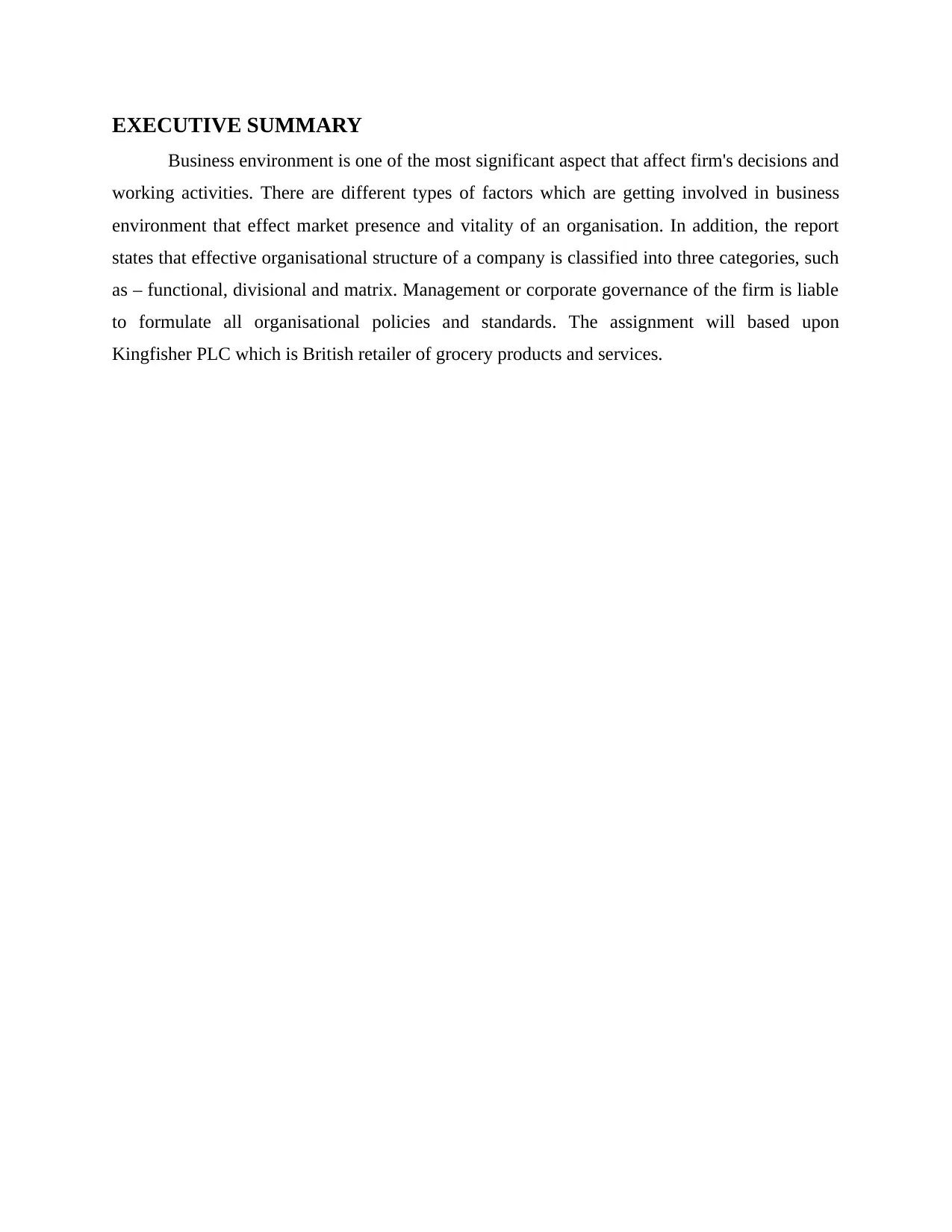
EXECUTIVE SUMMARY
Business environment is one of the most significant aspect that affect firm's decisions and
working activities. There are different types of factors which are getting involved in business
environment that effect market presence and vitality of an organisation. In addition, the report
states that effective organisational structure of a company is classified into three categories, such
as – functional, divisional and matrix. Management or corporate governance of the firm is liable
to formulate all organisational policies and standards. The assignment will based upon
Kingfisher PLC which is British retailer of grocery products and services.
Business environment is one of the most significant aspect that affect firm's decisions and
working activities. There are different types of factors which are getting involved in business
environment that effect market presence and vitality of an organisation. In addition, the report
states that effective organisational structure of a company is classified into three categories, such
as – functional, divisional and matrix. Management or corporate governance of the firm is liable
to formulate all organisational policies and standards. The assignment will based upon
Kingfisher PLC which is British retailer of grocery products and services.
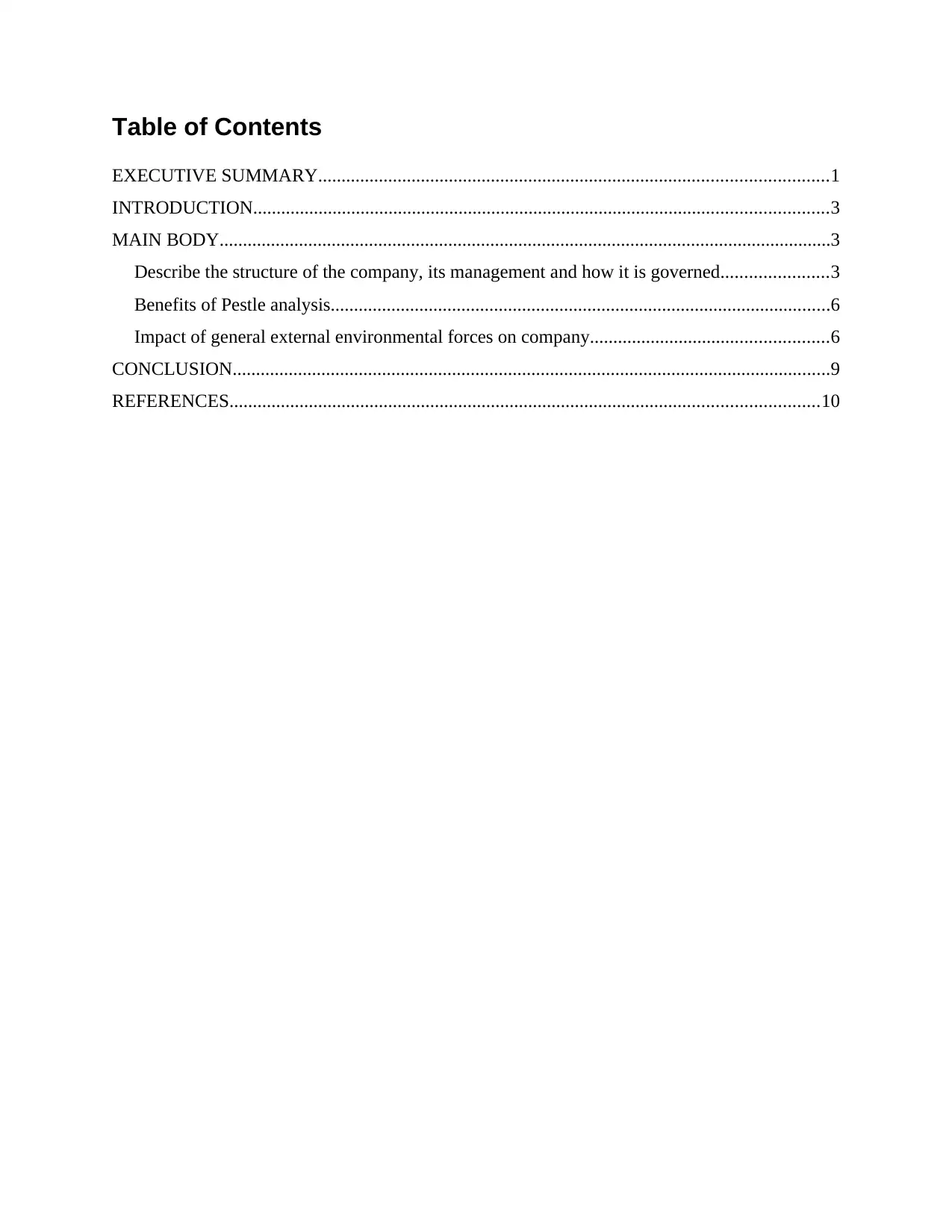
Table of Contents
EXECUTIVE SUMMARY.............................................................................................................1
INTRODUCTION...........................................................................................................................3
MAIN BODY...................................................................................................................................3
Describe the structure of the company, its management and how it is governed.......................3
Benefits of Pestle analysis...........................................................................................................6
Impact of general external environmental forces on company...................................................6
CONCLUSION................................................................................................................................9
REFERENCES..............................................................................................................................10
EXECUTIVE SUMMARY.............................................................................................................1
INTRODUCTION...........................................................................................................................3
MAIN BODY...................................................................................................................................3
Describe the structure of the company, its management and how it is governed.......................3
Benefits of Pestle analysis...........................................................................................................6
Impact of general external environmental forces on company...................................................6
CONCLUSION................................................................................................................................9
REFERENCES..............................................................................................................................10
⊘ This is a preview!⊘
Do you want full access?
Subscribe today to unlock all pages.

Trusted by 1+ million students worldwide
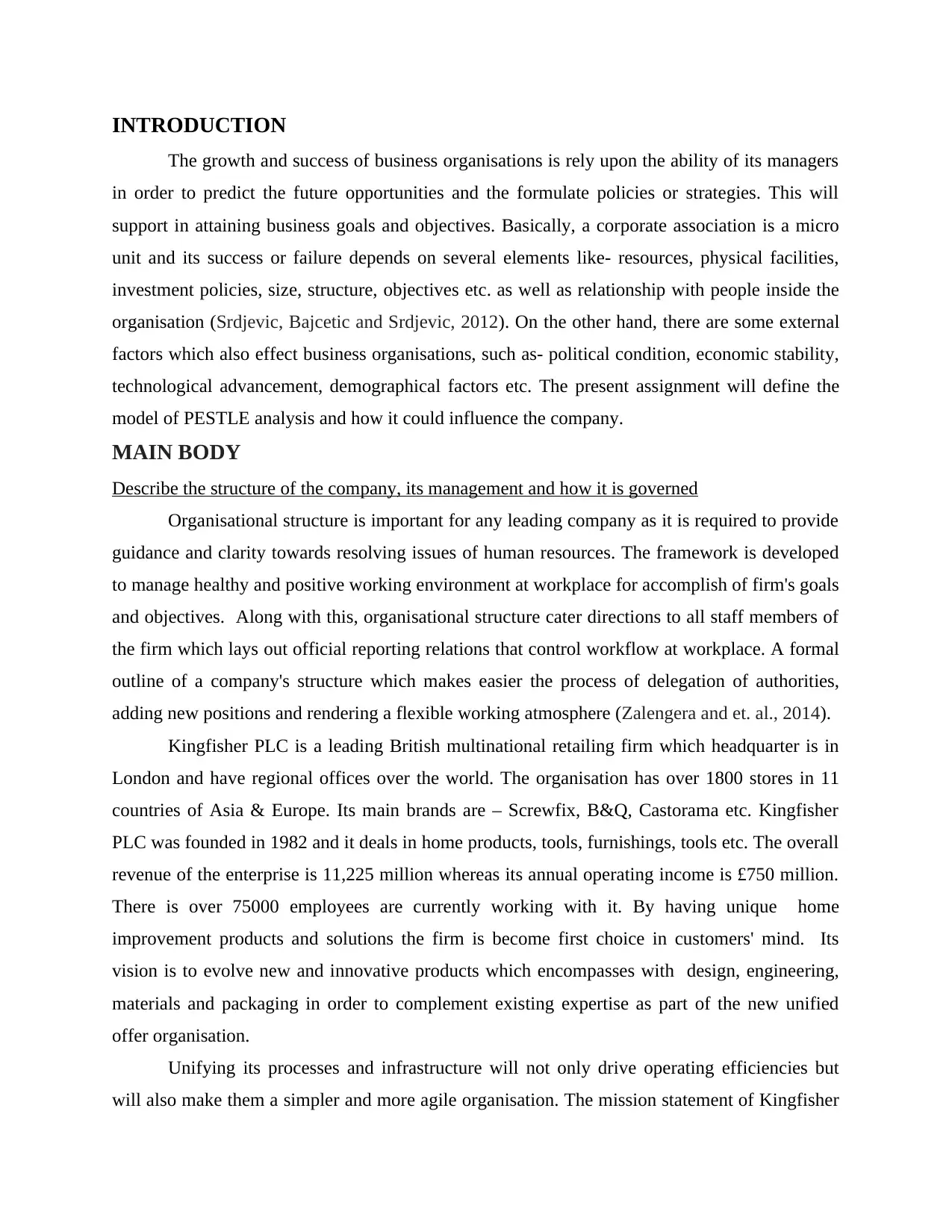
INTRODUCTION
The growth and success of business organisations is rely upon the ability of its managers
in order to predict the future opportunities and the formulate policies or strategies. This will
support in attaining business goals and objectives. Basically, a corporate association is a micro
unit and its success or failure depends on several elements like- resources, physical facilities,
investment policies, size, structure, objectives etc. as well as relationship with people inside the
organisation (Srdjevic, Bajcetic and Srdjevic, 2012). On the other hand, there are some external
factors which also effect business organisations, such as- political condition, economic stability,
technological advancement, demographical factors etc. The present assignment will define the
model of PESTLE analysis and how it could influence the company.
MAIN BODY
Describe the structure of the company, its management and how it is governed
Organisational structure is important for any leading company as it is required to provide
guidance and clarity towards resolving issues of human resources. The framework is developed
to manage healthy and positive working environment at workplace for accomplish of firm's goals
and objectives. Along with this, organisational structure cater directions to all staff members of
the firm which lays out official reporting relations that control workflow at workplace. A formal
outline of a company's structure which makes easier the process of delegation of authorities,
adding new positions and rendering a flexible working atmosphere (Zalengera and et. al., 2014).
Kingfisher PLC is a leading British multinational retailing firm which headquarter is in
London and have regional offices over the world. The organisation has over 1800 stores in 11
countries of Asia & Europe. Its main brands are – Screwfix, B&Q, Castorama etc. Kingfisher
PLC was founded in 1982 and it deals in home products, tools, furnishings, tools etc. The overall
revenue of the enterprise is 11,225 million whereas its annual operating income is £750 million.
There is over 75000 employees are currently working with it. By having unique home
improvement products and solutions the firm is become first choice in customers' mind. Its
vision is to evolve new and innovative products which encompasses with design, engineering,
materials and packaging in order to complement existing expertise as part of the new unified
offer organisation.
Unifying its processes and infrastructure will not only drive operating efficiencies but
will also make them a simpler and more agile organisation. The mission statement of Kingfisher
The growth and success of business organisations is rely upon the ability of its managers
in order to predict the future opportunities and the formulate policies or strategies. This will
support in attaining business goals and objectives. Basically, a corporate association is a micro
unit and its success or failure depends on several elements like- resources, physical facilities,
investment policies, size, structure, objectives etc. as well as relationship with people inside the
organisation (Srdjevic, Bajcetic and Srdjevic, 2012). On the other hand, there are some external
factors which also effect business organisations, such as- political condition, economic stability,
technological advancement, demographical factors etc. The present assignment will define the
model of PESTLE analysis and how it could influence the company.
MAIN BODY
Describe the structure of the company, its management and how it is governed
Organisational structure is important for any leading company as it is required to provide
guidance and clarity towards resolving issues of human resources. The framework is developed
to manage healthy and positive working environment at workplace for accomplish of firm's goals
and objectives. Along with this, organisational structure cater directions to all staff members of
the firm which lays out official reporting relations that control workflow at workplace. A formal
outline of a company's structure which makes easier the process of delegation of authorities,
adding new positions and rendering a flexible working atmosphere (Zalengera and et. al., 2014).
Kingfisher PLC is a leading British multinational retailing firm which headquarter is in
London and have regional offices over the world. The organisation has over 1800 stores in 11
countries of Asia & Europe. Its main brands are – Screwfix, B&Q, Castorama etc. Kingfisher
PLC was founded in 1982 and it deals in home products, tools, furnishings, tools etc. The overall
revenue of the enterprise is 11,225 million whereas its annual operating income is £750 million.
There is over 75000 employees are currently working with it. By having unique home
improvement products and solutions the firm is become first choice in customers' mind. Its
vision is to evolve new and innovative products which encompasses with design, engineering,
materials and packaging in order to complement existing expertise as part of the new unified
offer organisation.
Unifying its processes and infrastructure will not only drive operating efficiencies but
will also make them a simpler and more agile organisation. The mission statement of Kingfisher
Paraphrase This Document
Need a fresh take? Get an instant paraphrase of this document with our AI Paraphraser
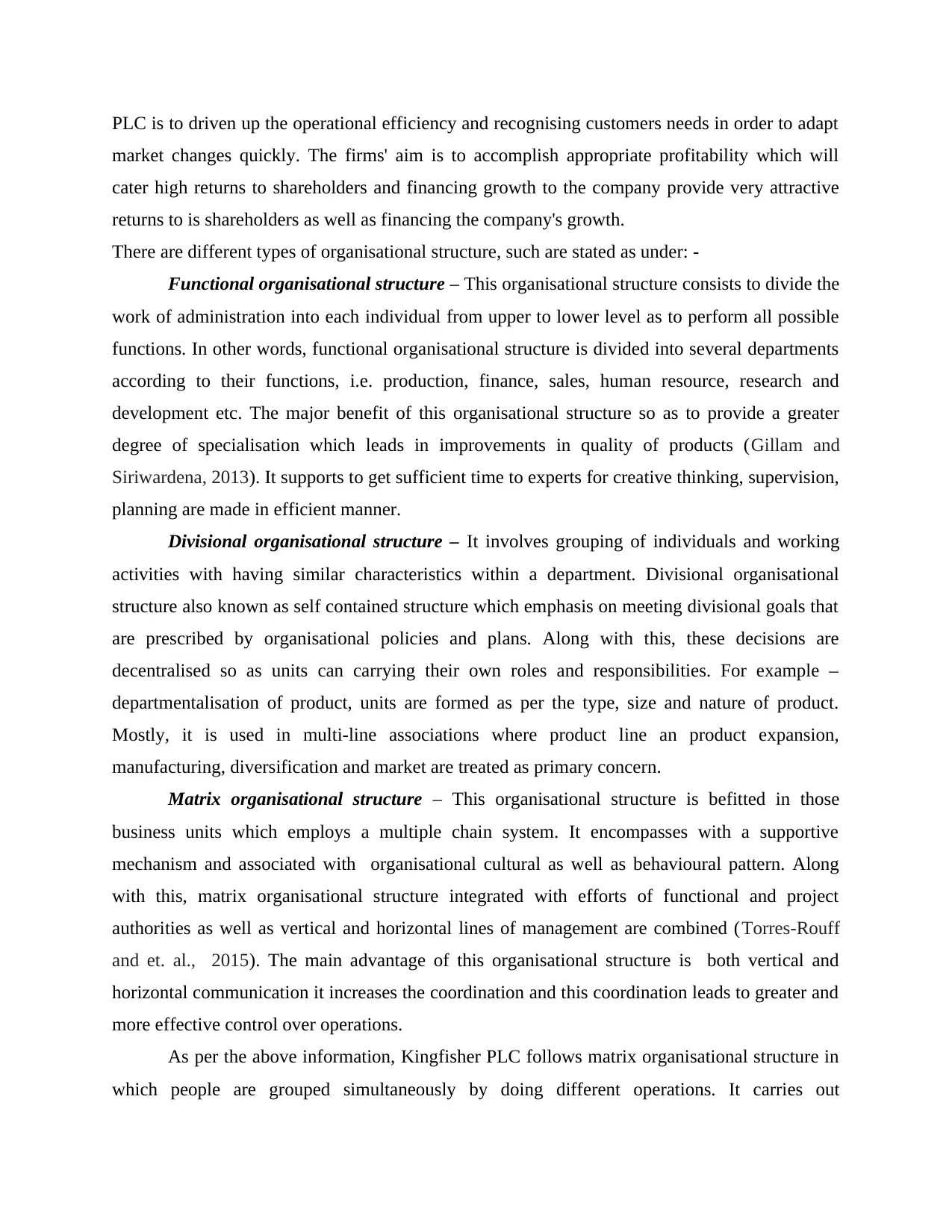
PLC is to driven up the operational efficiency and recognising customers needs in order to adapt
market changes quickly. The firms' aim is to accomplish appropriate profitability which will
cater high returns to shareholders and financing growth to the company provide very attractive
returns to is shareholders as well as financing the company's growth.
There are different types of organisational structure, such are stated as under: -
Functional organisational structure – This organisational structure consists to divide the
work of administration into each individual from upper to lower level as to perform all possible
functions. In other words, functional organisational structure is divided into several departments
according to their functions, i.e. production, finance, sales, human resource, research and
development etc. The major benefit of this organisational structure so as to provide a greater
degree of specialisation which leads in improvements in quality of products (Gillam and
Siriwardena, 2013). It supports to get sufficient time to experts for creative thinking, supervision,
planning are made in efficient manner.
Divisional organisational structure – It involves grouping of individuals and working
activities with having similar characteristics within a department. Divisional organisational
structure also known as self contained structure which emphasis on meeting divisional goals that
are prescribed by organisational policies and plans. Along with this, these decisions are
decentralised so as units can carrying their own roles and responsibilities. For example –
departmentalisation of product, units are formed as per the type, size and nature of product.
Mostly, it is used in multi-line associations where product line an product expansion,
manufacturing, diversification and market are treated as primary concern.
Matrix organisational structure – This organisational structure is befitted in those
business units which employs a multiple chain system. It encompasses with a supportive
mechanism and associated with organisational cultural as well as behavioural pattern. Along
with this, matrix organisational structure integrated with efforts of functional and project
authorities as well as vertical and horizontal lines of management are combined (Torres‐Rouff
and et. al., 2015). The main advantage of this organisational structure is both vertical and
horizontal communication it increases the coordination and this coordination leads to greater and
more effective control over operations.
As per the above information, Kingfisher PLC follows matrix organisational structure in
which people are grouped simultaneously by doing different operations. It carries out
market changes quickly. The firms' aim is to accomplish appropriate profitability which will
cater high returns to shareholders and financing growth to the company provide very attractive
returns to is shareholders as well as financing the company's growth.
There are different types of organisational structure, such are stated as under: -
Functional organisational structure – This organisational structure consists to divide the
work of administration into each individual from upper to lower level as to perform all possible
functions. In other words, functional organisational structure is divided into several departments
according to their functions, i.e. production, finance, sales, human resource, research and
development etc. The major benefit of this organisational structure so as to provide a greater
degree of specialisation which leads in improvements in quality of products (Gillam and
Siriwardena, 2013). It supports to get sufficient time to experts for creative thinking, supervision,
planning are made in efficient manner.
Divisional organisational structure – It involves grouping of individuals and working
activities with having similar characteristics within a department. Divisional organisational
structure also known as self contained structure which emphasis on meeting divisional goals that
are prescribed by organisational policies and plans. Along with this, these decisions are
decentralised so as units can carrying their own roles and responsibilities. For example –
departmentalisation of product, units are formed as per the type, size and nature of product.
Mostly, it is used in multi-line associations where product line an product expansion,
manufacturing, diversification and market are treated as primary concern.
Matrix organisational structure – This organisational structure is befitted in those
business units which employs a multiple chain system. It encompasses with a supportive
mechanism and associated with organisational cultural as well as behavioural pattern. Along
with this, matrix organisational structure integrated with efforts of functional and project
authorities as well as vertical and horizontal lines of management are combined (Torres‐Rouff
and et. al., 2015). The main advantage of this organisational structure is both vertical and
horizontal communication it increases the coordination and this coordination leads to greater and
more effective control over operations.
As per the above information, Kingfisher PLC follows matrix organisational structure in
which people are grouped simultaneously by doing different operations. It carries out
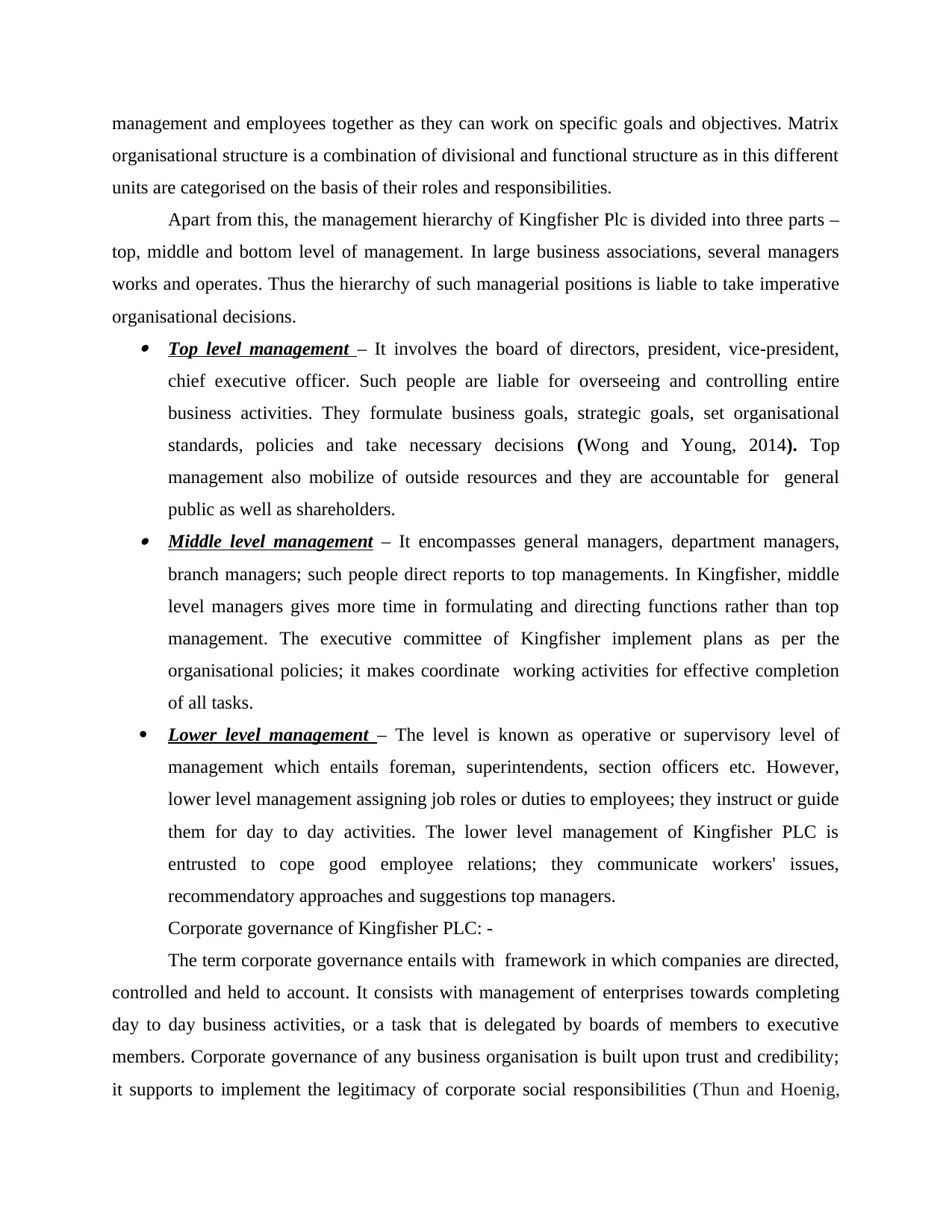
management and employees together as they can work on specific goals and objectives. Matrix
organisational structure is a combination of divisional and functional structure as in this different
units are categorised on the basis of their roles and responsibilities.
Apart from this, the management hierarchy of Kingfisher Plc is divided into three parts –
top, middle and bottom level of management. In large business associations, several managers
works and operates. Thus the hierarchy of such managerial positions is liable to take imperative
organisational decisions. Top level management – It involves the board of directors, president, vice-president,
chief executive officer. Such people are liable for overseeing and controlling entire
business activities. They formulate business goals, strategic goals, set organisational
standards, policies and take necessary decisions (Wong and Young, 2014). Top
management also mobilize of outside resources and they are accountable for general
public as well as shareholders. Middle level management – It encompasses general managers, department managers,
branch managers; such people direct reports to top managements. In Kingfisher, middle
level managers gives more time in formulating and directing functions rather than top
management. The executive committee of Kingfisher implement plans as per the
organisational policies; it makes coordinate working activities for effective completion
of all tasks.
Lower level management – The level is known as operative or supervisory level of
management which entails foreman, superintendents, section officers etc. However,
lower level management assigning job roles or duties to employees; they instruct or guide
them for day to day activities. The lower level management of Kingfisher PLC is
entrusted to cope good employee relations; they communicate workers' issues,
recommendatory approaches and suggestions top managers.
Corporate governance of Kingfisher PLC: -
The term corporate governance entails with framework in which companies are directed,
controlled and held to account. It consists with management of enterprises towards completing
day to day business activities, or a task that is delegated by boards of members to executive
members. Corporate governance of any business organisation is built upon trust and credibility;
it supports to implement the legitimacy of corporate social responsibilities (Thun and Hoenig,
organisational structure is a combination of divisional and functional structure as in this different
units are categorised on the basis of their roles and responsibilities.
Apart from this, the management hierarchy of Kingfisher Plc is divided into three parts –
top, middle and bottom level of management. In large business associations, several managers
works and operates. Thus the hierarchy of such managerial positions is liable to take imperative
organisational decisions. Top level management – It involves the board of directors, president, vice-president,
chief executive officer. Such people are liable for overseeing and controlling entire
business activities. They formulate business goals, strategic goals, set organisational
standards, policies and take necessary decisions (Wong and Young, 2014). Top
management also mobilize of outside resources and they are accountable for general
public as well as shareholders. Middle level management – It encompasses general managers, department managers,
branch managers; such people direct reports to top managements. In Kingfisher, middle
level managers gives more time in formulating and directing functions rather than top
management. The executive committee of Kingfisher implement plans as per the
organisational policies; it makes coordinate working activities for effective completion
of all tasks.
Lower level management – The level is known as operative or supervisory level of
management which entails foreman, superintendents, section officers etc. However,
lower level management assigning job roles or duties to employees; they instruct or guide
them for day to day activities. The lower level management of Kingfisher PLC is
entrusted to cope good employee relations; they communicate workers' issues,
recommendatory approaches and suggestions top managers.
Corporate governance of Kingfisher PLC: -
The term corporate governance entails with framework in which companies are directed,
controlled and held to account. It consists with management of enterprises towards completing
day to day business activities, or a task that is delegated by boards of members to executive
members. Corporate governance of any business organisation is built upon trust and credibility;
it supports to implement the legitimacy of corporate social responsibilities (Thun and Hoenig,
⊘ This is a preview!⊘
Do you want full access?
Subscribe today to unlock all pages.

Trusted by 1+ million students worldwide
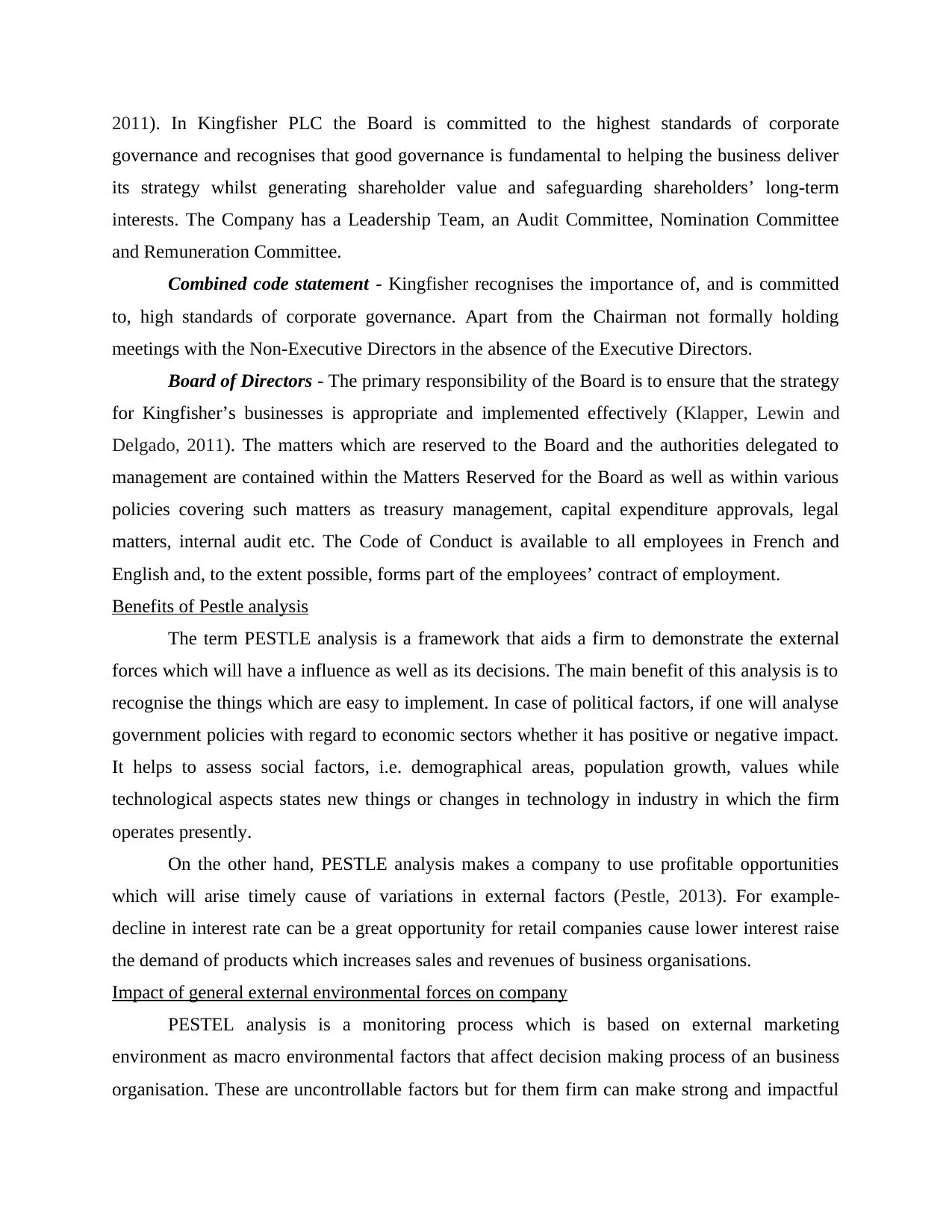
2011). In Kingfisher PLC the Board is committed to the highest standards of corporate
governance and recognises that good governance is fundamental to helping the business deliver
its strategy whilst generating shareholder value and safeguarding shareholders’ long-term
interests. The Company has a Leadership Team, an Audit Committee, Nomination Committee
and Remuneration Committee.
Combined code statement - Kingfisher recognises the importance of, and is committed
to, high standards of corporate governance. Apart from the Chairman not formally holding
meetings with the Non-Executive Directors in the absence of the Executive Directors.
Board of Directors - The primary responsibility of the Board is to ensure that the strategy
for Kingfisher’s businesses is appropriate and implemented effectively (Klapper, Lewin and
Delgado, 2011). The matters which are reserved to the Board and the authorities delegated to
management are contained within the Matters Reserved for the Board as well as within various
policies covering such matters as treasury management, capital expenditure approvals, legal
matters, internal audit etc. The Code of Conduct is available to all employees in French and
English and, to the extent possible, forms part of the employees’ contract of employment.
Benefits of Pestle analysis
The term PESTLE analysis is a framework that aids a firm to demonstrate the external
forces which will have a influence as well as its decisions. The main benefit of this analysis is to
recognise the things which are easy to implement. In case of political factors, if one will analyse
government policies with regard to economic sectors whether it has positive or negative impact.
It helps to assess social factors, i.e. demographical areas, population growth, values while
technological aspects states new things or changes in technology in industry in which the firm
operates presently.
On the other hand, PESTLE analysis makes a company to use profitable opportunities
which will arise timely cause of variations in external factors (Pestle, 2013). For example-
decline in interest rate can be a great opportunity for retail companies cause lower interest raise
the demand of products which increases sales and revenues of business organisations.
Impact of general external environmental forces on company
PESTEL analysis is a monitoring process which is based on external marketing
environment as macro environmental factors that affect decision making process of an business
organisation. These are uncontrollable factors but for them firm can make strong and impactful
governance and recognises that good governance is fundamental to helping the business deliver
its strategy whilst generating shareholder value and safeguarding shareholders’ long-term
interests. The Company has a Leadership Team, an Audit Committee, Nomination Committee
and Remuneration Committee.
Combined code statement - Kingfisher recognises the importance of, and is committed
to, high standards of corporate governance. Apart from the Chairman not formally holding
meetings with the Non-Executive Directors in the absence of the Executive Directors.
Board of Directors - The primary responsibility of the Board is to ensure that the strategy
for Kingfisher’s businesses is appropriate and implemented effectively (Klapper, Lewin and
Delgado, 2011). The matters which are reserved to the Board and the authorities delegated to
management are contained within the Matters Reserved for the Board as well as within various
policies covering such matters as treasury management, capital expenditure approvals, legal
matters, internal audit etc. The Code of Conduct is available to all employees in French and
English and, to the extent possible, forms part of the employees’ contract of employment.
Benefits of Pestle analysis
The term PESTLE analysis is a framework that aids a firm to demonstrate the external
forces which will have a influence as well as its decisions. The main benefit of this analysis is to
recognise the things which are easy to implement. In case of political factors, if one will analyse
government policies with regard to economic sectors whether it has positive or negative impact.
It helps to assess social factors, i.e. demographical areas, population growth, values while
technological aspects states new things or changes in technology in industry in which the firm
operates presently.
On the other hand, PESTLE analysis makes a company to use profitable opportunities
which will arise timely cause of variations in external factors (Pestle, 2013). For example-
decline in interest rate can be a great opportunity for retail companies cause lower interest raise
the demand of products which increases sales and revenues of business organisations.
Impact of general external environmental forces on company
PESTEL analysis is a monitoring process which is based on external marketing
environment as macro environmental factors that affect decision making process of an business
organisation. These are uncontrollable factors but for them firm can make strong and impactful
Paraphrase This Document
Need a fresh take? Get an instant paraphrase of this document with our AI Paraphraser
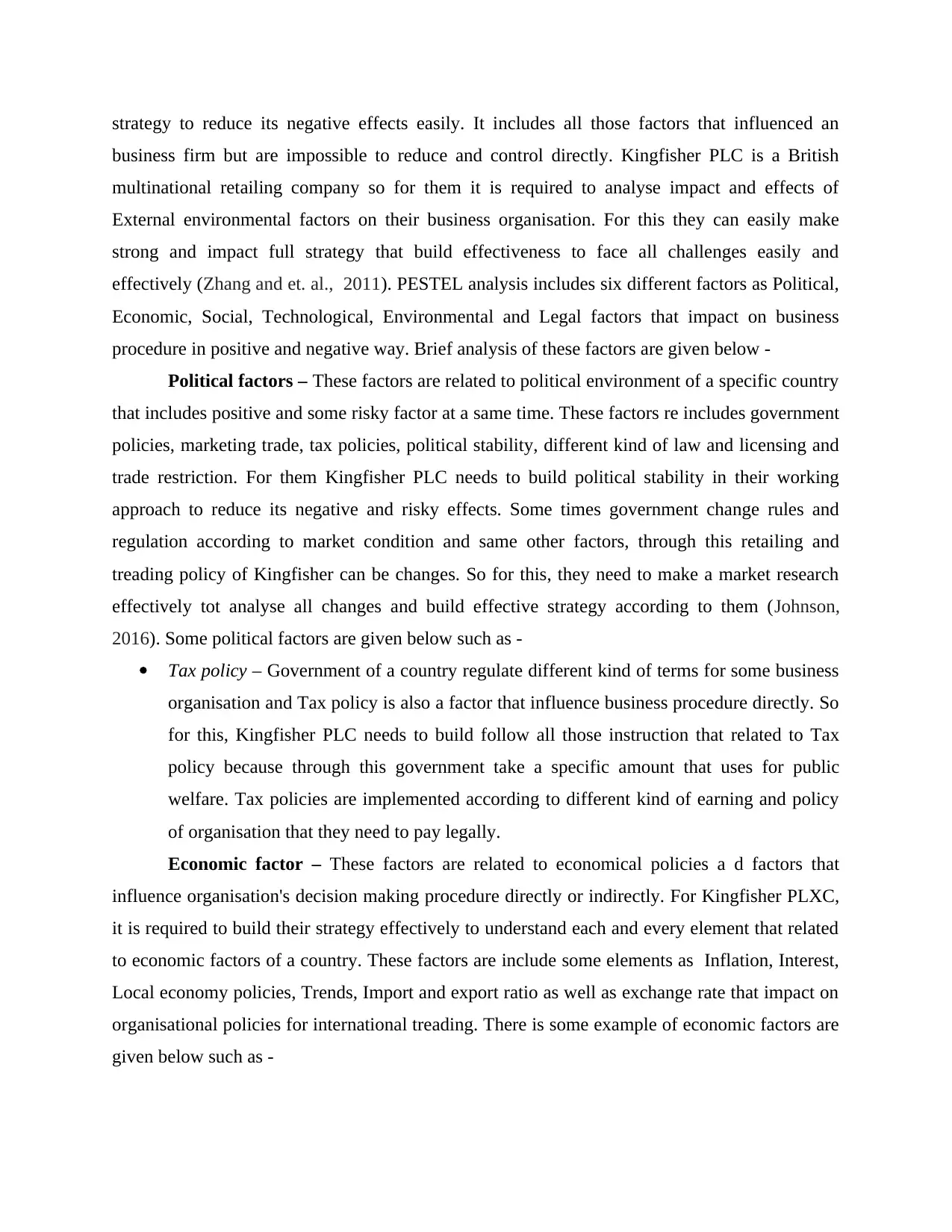
strategy to reduce its negative effects easily. It includes all those factors that influenced an
business firm but are impossible to reduce and control directly. Kingfisher PLC is a British
multinational retailing company so for them it is required to analyse impact and effects of
External environmental factors on their business organisation. For this they can easily make
strong and impact full strategy that build effectiveness to face all challenges easily and
effectively (Zhang and et. al., 2011). PESTEL analysis includes six different factors as Political,
Economic, Social, Technological, Environmental and Legal factors that impact on business
procedure in positive and negative way. Brief analysis of these factors are given below -
Political factors – These factors are related to political environment of a specific country
that includes positive and some risky factor at a same time. These factors re includes government
policies, marketing trade, tax policies, political stability, different kind of law and licensing and
trade restriction. For them Kingfisher PLC needs to build political stability in their working
approach to reduce its negative and risky effects. Some times government change rules and
regulation according to market condition and same other factors, through this retailing and
treading policy of Kingfisher can be changes. So for this, they need to make a market research
effectively tot analyse all changes and build effective strategy according to them (Johnson,
2016). Some political factors are given below such as -
Tax policy – Government of a country regulate different kind of terms for some business
organisation and Tax policy is also a factor that influence business procedure directly. So
for this, Kingfisher PLC needs to build follow all those instruction that related to Tax
policy because through this government take a specific amount that uses for public
welfare. Tax policies are implemented according to different kind of earning and policy
of organisation that they need to pay legally.
Economic factor – These factors are related to economical policies a d factors that
influence organisation's decision making procedure directly or indirectly. For Kingfisher PLXC,
it is required to build their strategy effectively to understand each and every element that related
to economic factors of a country. These factors are include some elements as Inflation, Interest,
Local economy policies, Trends, Import and export ratio as well as exchange rate that impact on
organisational policies for international treading. There is some example of economic factors are
given below such as -
business firm but are impossible to reduce and control directly. Kingfisher PLC is a British
multinational retailing company so for them it is required to analyse impact and effects of
External environmental factors on their business organisation. For this they can easily make
strong and impact full strategy that build effectiveness to face all challenges easily and
effectively (Zhang and et. al., 2011). PESTEL analysis includes six different factors as Political,
Economic, Social, Technological, Environmental and Legal factors that impact on business
procedure in positive and negative way. Brief analysis of these factors are given below -
Political factors – These factors are related to political environment of a specific country
that includes positive and some risky factor at a same time. These factors re includes government
policies, marketing trade, tax policies, political stability, different kind of law and licensing and
trade restriction. For them Kingfisher PLC needs to build political stability in their working
approach to reduce its negative and risky effects. Some times government change rules and
regulation according to market condition and same other factors, through this retailing and
treading policy of Kingfisher can be changes. So for this, they need to make a market research
effectively tot analyse all changes and build effective strategy according to them (Johnson,
2016). Some political factors are given below such as -
Tax policy – Government of a country regulate different kind of terms for some business
organisation and Tax policy is also a factor that influence business procedure directly. So
for this, Kingfisher PLC needs to build follow all those instruction that related to Tax
policy because through this government take a specific amount that uses for public
welfare. Tax policies are implemented according to different kind of earning and policy
of organisation that they need to pay legally.
Economic factor – These factors are related to economical policies a d factors that
influence organisation's decision making procedure directly or indirectly. For Kingfisher PLXC,
it is required to build their strategy effectively to understand each and every element that related
to economic factors of a country. These factors are include some elements as Inflation, Interest,
Local economy policies, Trends, Import and export ratio as well as exchange rate that impact on
organisational policies for international treading. There is some example of economic factors are
given below such as -
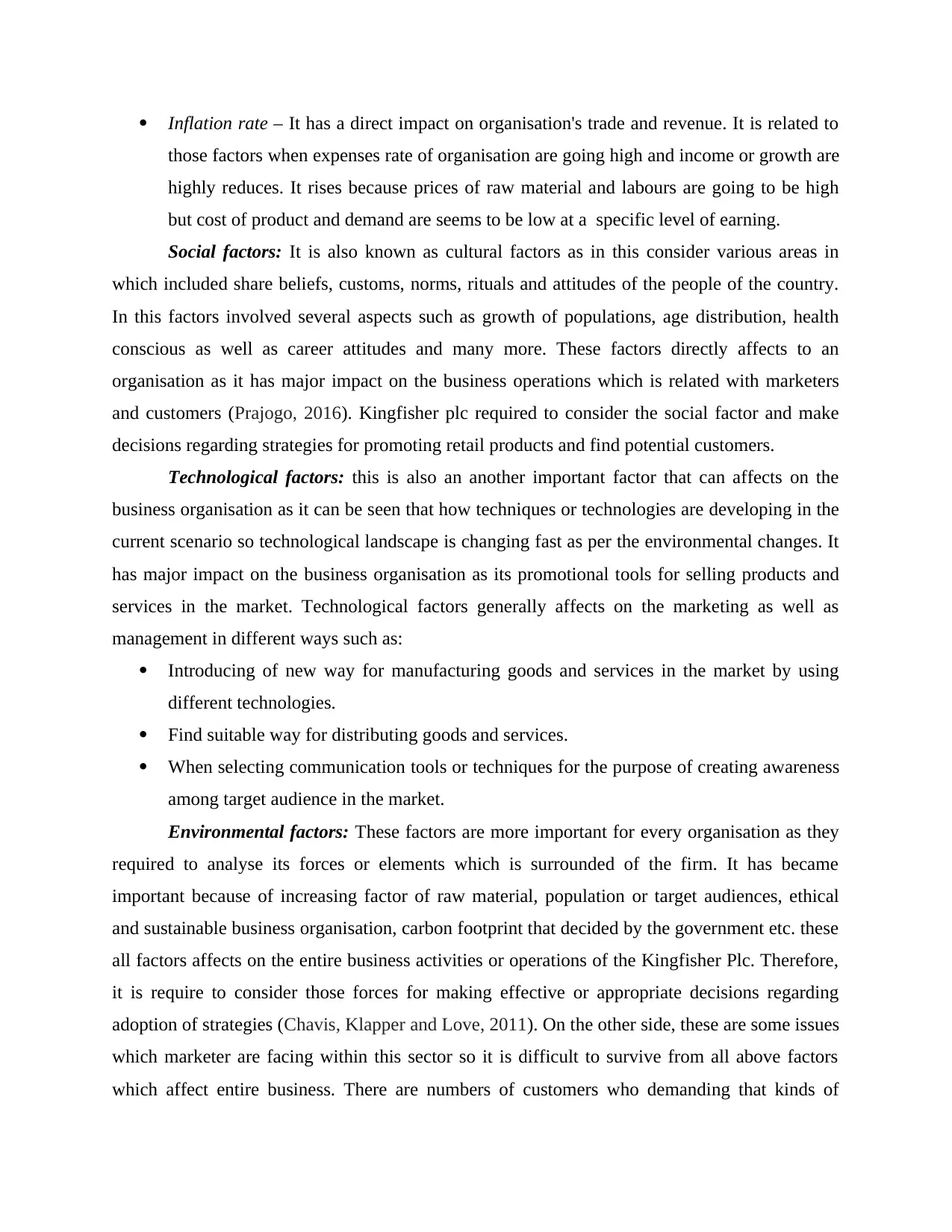
Inflation rate – It has a direct impact on organisation's trade and revenue. It is related to
those factors when expenses rate of organisation are going high and income or growth are
highly reduces. It rises because prices of raw material and labours are going to be high
but cost of product and demand are seems to be low at a specific level of earning.
Social factors: It is also known as cultural factors as in this consider various areas in
which included share beliefs, customs, norms, rituals and attitudes of the people of the country.
In this factors involved several aspects such as growth of populations, age distribution, health
conscious as well as career attitudes and many more. These factors directly affects to an
organisation as it has major impact on the business operations which is related with marketers
and customers (Prajogo, 2016). Kingfisher plc required to consider the social factor and make
decisions regarding strategies for promoting retail products and find potential customers.
Technological factors: this is also an another important factor that can affects on the
business organisation as it can be seen that how techniques or technologies are developing in the
current scenario so technological landscape is changing fast as per the environmental changes. It
has major impact on the business organisation as its promotional tools for selling products and
services in the market. Technological factors generally affects on the marketing as well as
management in different ways such as:
Introducing of new way for manufacturing goods and services in the market by using
different technologies.
Find suitable way for distributing goods and services.
When selecting communication tools or techniques for the purpose of creating awareness
among target audience in the market.
Environmental factors: These factors are more important for every organisation as they
required to analyse its forces or elements which is surrounded of the firm. It has became
important because of increasing factor of raw material, population or target audiences, ethical
and sustainable business organisation, carbon footprint that decided by the government etc. these
all factors affects on the entire business activities or operations of the Kingfisher Plc. Therefore,
it is require to consider those forces for making effective or appropriate decisions regarding
adoption of strategies (Chavis, Klapper and Love, 2011). On the other side, these are some issues
which marketer are facing within this sector so it is difficult to survive from all above factors
which affect entire business. There are numbers of customers who demanding that kinds of
those factors when expenses rate of organisation are going high and income or growth are
highly reduces. It rises because prices of raw material and labours are going to be high
but cost of product and demand are seems to be low at a specific level of earning.
Social factors: It is also known as cultural factors as in this consider various areas in
which included share beliefs, customs, norms, rituals and attitudes of the people of the country.
In this factors involved several aspects such as growth of populations, age distribution, health
conscious as well as career attitudes and many more. These factors directly affects to an
organisation as it has major impact on the business operations which is related with marketers
and customers (Prajogo, 2016). Kingfisher plc required to consider the social factor and make
decisions regarding strategies for promoting retail products and find potential customers.
Technological factors: this is also an another important factor that can affects on the
business organisation as it can be seen that how techniques or technologies are developing in the
current scenario so technological landscape is changing fast as per the environmental changes. It
has major impact on the business organisation as its promotional tools for selling products and
services in the market. Technological factors generally affects on the marketing as well as
management in different ways such as:
Introducing of new way for manufacturing goods and services in the market by using
different technologies.
Find suitable way for distributing goods and services.
When selecting communication tools or techniques for the purpose of creating awareness
among target audience in the market.
Environmental factors: These factors are more important for every organisation as they
required to analyse its forces or elements which is surrounded of the firm. It has became
important because of increasing factor of raw material, population or target audiences, ethical
and sustainable business organisation, carbon footprint that decided by the government etc. these
all factors affects on the entire business activities or operations of the Kingfisher Plc. Therefore,
it is require to consider those forces for making effective or appropriate decisions regarding
adoption of strategies (Chavis, Klapper and Love, 2011). On the other side, these are some issues
which marketer are facing within this sector so it is difficult to survive from all above factors
which affect entire business. There are numbers of customers who demanding that kinds of
⊘ This is a preview!⊘
Do you want full access?
Subscribe today to unlock all pages.

Trusted by 1+ million students worldwide
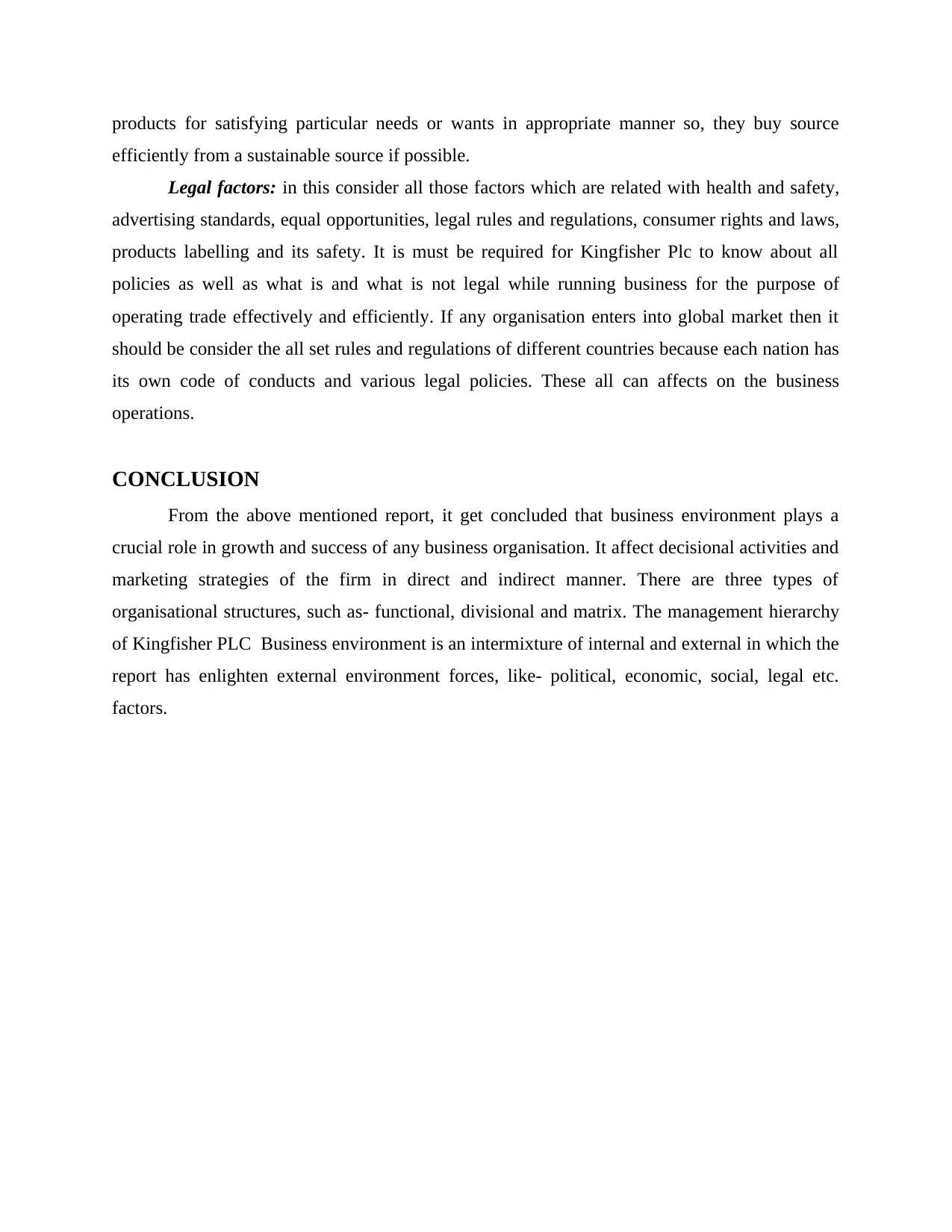
products for satisfying particular needs or wants in appropriate manner so, they buy source
efficiently from a sustainable source if possible.
Legal factors: in this consider all those factors which are related with health and safety,
advertising standards, equal opportunities, legal rules and regulations, consumer rights and laws,
products labelling and its safety. It is must be required for Kingfisher Plc to know about all
policies as well as what is and what is not legal while running business for the purpose of
operating trade effectively and efficiently. If any organisation enters into global market then it
should be consider the all set rules and regulations of different countries because each nation has
its own code of conducts and various legal policies. These all can affects on the business
operations.
CONCLUSION
From the above mentioned report, it get concluded that business environment plays a
crucial role in growth and success of any business organisation. It affect decisional activities and
marketing strategies of the firm in direct and indirect manner. There are three types of
organisational structures, such as- functional, divisional and matrix. The management hierarchy
of Kingfisher PLC Business environment is an intermixture of internal and external in which the
report has enlighten external environment forces, like- political, economic, social, legal etc.
factors.
efficiently from a sustainable source if possible.
Legal factors: in this consider all those factors which are related with health and safety,
advertising standards, equal opportunities, legal rules and regulations, consumer rights and laws,
products labelling and its safety. It is must be required for Kingfisher Plc to know about all
policies as well as what is and what is not legal while running business for the purpose of
operating trade effectively and efficiently. If any organisation enters into global market then it
should be consider the all set rules and regulations of different countries because each nation has
its own code of conducts and various legal policies. These all can affects on the business
operations.
CONCLUSION
From the above mentioned report, it get concluded that business environment plays a
crucial role in growth and success of any business organisation. It affect decisional activities and
marketing strategies of the firm in direct and indirect manner. There are three types of
organisational structures, such as- functional, divisional and matrix. The management hierarchy
of Kingfisher PLC Business environment is an intermixture of internal and external in which the
report has enlighten external environment forces, like- political, economic, social, legal etc.
factors.
Paraphrase This Document
Need a fresh take? Get an instant paraphrase of this document with our AI Paraphraser
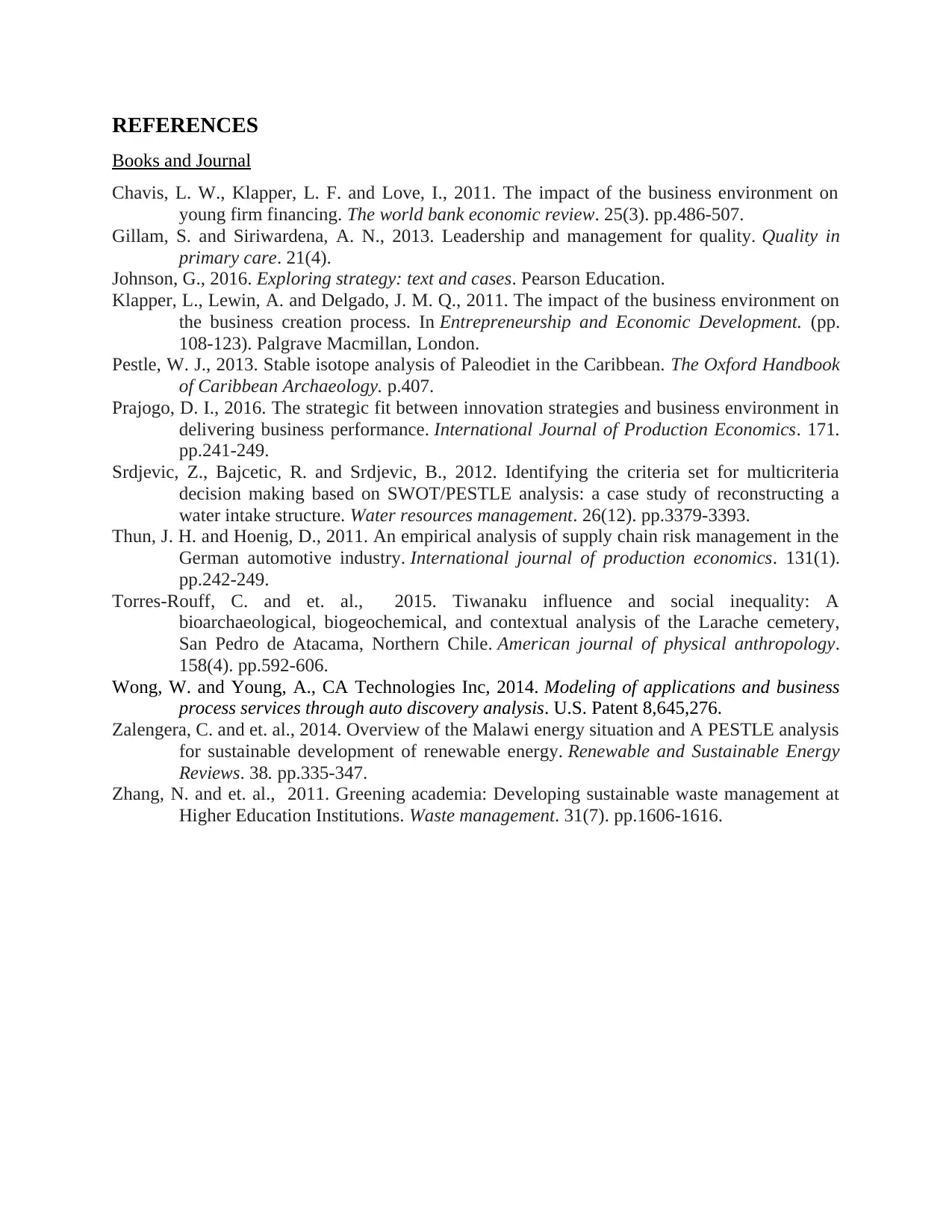
REFERENCES
Books and Journal
Chavis, L. W., Klapper, L. F. and Love, I., 2011. The impact of the business environment on
young firm financing. The world bank economic review. 25(3). pp.486-507.
Gillam, S. and Siriwardena, A. N., 2013. Leadership and management for quality. Quality in
primary care. 21(4).
Johnson, G., 2016. Exploring strategy: text and cases. Pearson Education.
Klapper, L., Lewin, A. and Delgado, J. M. Q., 2011. The impact of the business environment on
the business creation process. In Entrepreneurship and Economic Development. (pp.
108-123). Palgrave Macmillan, London.
Pestle, W. J., 2013. Stable isotope analysis of Paleodiet in the Caribbean. The Oxford Handbook
of Caribbean Archaeology. p.407.
Prajogo, D. I., 2016. The strategic fit between innovation strategies and business environment in
delivering business performance. International Journal of Production Economics. 171.
pp.241-249.
Srdjevic, Z., Bajcetic, R. and Srdjevic, B., 2012. Identifying the criteria set for multicriteria
decision making based on SWOT/PESTLE analysis: a case study of reconstructing a
water intake structure. Water resources management. 26(12). pp.3379-3393.
Thun, J. H. and Hoenig, D., 2011. An empirical analysis of supply chain risk management in the
German automotive industry. International journal of production economics. 131(1).
pp.242-249.
Torres‐Rouff, C. and et. al., 2015. Tiwanaku influence and social inequality: A
bioarchaeological, biogeochemical, and contextual analysis of the Larache cemetery,
San Pedro de Atacama, Northern Chile. American journal of physical anthropology.
158(4). pp.592-606.
Wong, W. and Young, A., CA Technologies Inc, 2014. Modeling of applications and business
process services through auto discovery analysis. U.S. Patent 8,645,276.
Zalengera, C. and et. al., 2014. Overview of the Malawi energy situation and A PESTLE analysis
for sustainable development of renewable energy. Renewable and Sustainable Energy
Reviews. 38. pp.335-347.
Zhang, N. and et. al., 2011. Greening academia: Developing sustainable waste management at
Higher Education Institutions. Waste management. 31(7). pp.1606-1616.
Books and Journal
Chavis, L. W., Klapper, L. F. and Love, I., 2011. The impact of the business environment on
young firm financing. The world bank economic review. 25(3). pp.486-507.
Gillam, S. and Siriwardena, A. N., 2013. Leadership and management for quality. Quality in
primary care. 21(4).
Johnson, G., 2016. Exploring strategy: text and cases. Pearson Education.
Klapper, L., Lewin, A. and Delgado, J. M. Q., 2011. The impact of the business environment on
the business creation process. In Entrepreneurship and Economic Development. (pp.
108-123). Palgrave Macmillan, London.
Pestle, W. J., 2013. Stable isotope analysis of Paleodiet in the Caribbean. The Oxford Handbook
of Caribbean Archaeology. p.407.
Prajogo, D. I., 2016. The strategic fit between innovation strategies and business environment in
delivering business performance. International Journal of Production Economics. 171.
pp.241-249.
Srdjevic, Z., Bajcetic, R. and Srdjevic, B., 2012. Identifying the criteria set for multicriteria
decision making based on SWOT/PESTLE analysis: a case study of reconstructing a
water intake structure. Water resources management. 26(12). pp.3379-3393.
Thun, J. H. and Hoenig, D., 2011. An empirical analysis of supply chain risk management in the
German automotive industry. International journal of production economics. 131(1).
pp.242-249.
Torres‐Rouff, C. and et. al., 2015. Tiwanaku influence and social inequality: A
bioarchaeological, biogeochemical, and contextual analysis of the Larache cemetery,
San Pedro de Atacama, Northern Chile. American journal of physical anthropology.
158(4). pp.592-606.
Wong, W. and Young, A., CA Technologies Inc, 2014. Modeling of applications and business
process services through auto discovery analysis. U.S. Patent 8,645,276.
Zalengera, C. and et. al., 2014. Overview of the Malawi energy situation and A PESTLE analysis
for sustainable development of renewable energy. Renewable and Sustainable Energy
Reviews. 38. pp.335-347.
Zhang, N. and et. al., 2011. Greening academia: Developing sustainable waste management at
Higher Education Institutions. Waste management. 31(7). pp.1606-1616.
1 out of 11
Related Documents
Your All-in-One AI-Powered Toolkit for Academic Success.
+13062052269
info@desklib.com
Available 24*7 on WhatsApp / Email
![[object Object]](/_next/static/media/star-bottom.7253800d.svg)
Unlock your academic potential
Copyright © 2020–2025 A2Z Services. All Rights Reserved. Developed and managed by ZUCOL.





